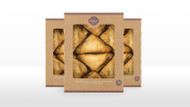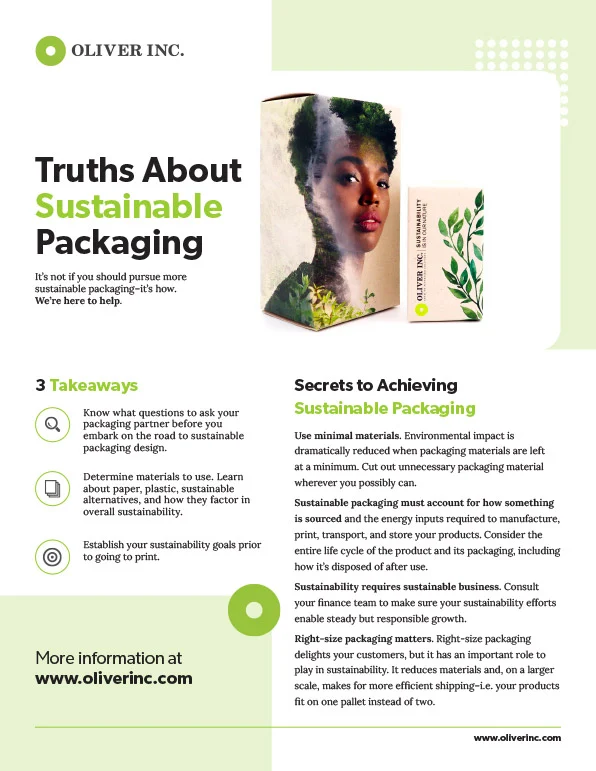Food Safe Packaging Boxes: What You Need to Know
Posted by Oliver Inc. on 3rd Dec 2020
In the highly competitive food and beverage industry, you have to consider every aspect of your packaging to stay ahead. That includes branding, shelf presence, sustainability, and, perhaps most importantly, safety.
To preserve and protect are the critical elements in defining food-safe packaging. It preserves the products’ shelf life, keeps them fresh (in taste and appearance), and holds up in the appropriate environment (whether fresh from the oven or in the frozen section). It protects food products during transportation, handling, distribution, and shelving.
On the other side, ignoring safe packaging (or minimizing its importance) puts your clients and brand at risk. Food contamination can happen at every point in the supply chain, and recalls are costly and damage reputations.
Here’s what you need to know about food-safe packaging boxes.
Safe Food Certifications
One of the first considerations for safe packaging is making sure the manufacturer is certified to handle food and beverage products. That may seem obvious, but it can’t be overlooked.
Internationally recognized by the Global Food Safety Initiative (GFSI), the Safe Quality Food (SQF) certification confirms that a company’s food safety and quality codes meet industry, customer, and regulatory requirements for all sectors of the supply chain. When you choose an SQF-certified packaging manufacturer, you commit to the highest global standards.
While other certifications—such as those related to quality, sustainability, and printing—aren’t directly tied to safety, they reflect the manufacturer’s commitment to their overarching quality system. That’s reassuring when looking for safe food packaging.
Design & Materials
A trend across industries, but especially relevant to food, is the movement away from plastics. Although plastic performs well and can effectively keep food safe, it’s not always a sustainable option.
Luckily, manufacturers have developed cost-effective paperboard boxes that present branding opportunities, protect your products against breaks and spills, and maintain their integrity.
So what goes into an effective box design? There are a number of factors that ensure food safety. The design should be optimized for your specific products with considerations for weight and shape. Windowing and barriers also promote freshness across different environments.
Barrier Coatings: Barrier coatings stand between your products and their packaging. The right barrier will allow you to maintain shelf life without sacrificing ingredients that might otherwise compromise the paperboard.
Windowing: A critical component of protection, windowing serves multiple roles. First, the materials used should support the appropriate temperature and account for condensation and breathability. Second, it gives customers a clear view of the product. They can identify that the food appears as intended, and the packaging has provided adequate protection.
Airflow: Controlling airflow maintains freshness. Windowing and the design of the paperboard itself should be optimized with that in mind.
Finally, strong finishes help prevent spills, breaks, and leaks. Keep in mind, too, that frozen foods require specialty treatments. The right adhesive selection and structure go a long way in keeping your products safe from the manufacturing facility to your customers’ tables.
Other Packaging Considerations
While safety is a primary concern, it’s only one aspect of the packaging. The good news is, if you work with the right manufacturer, you can take advantage of all aspects, including functionality, sustainability and branding, without jeopardizing safety. It’s built directly into the design.
Take windowing, for example. Although mainly serving a protective purpose, it can be used as a decorative element. You can play with the shape or highlight a particular detail of the product inside.
In addition, manufacturers that offer vendor managed inventory (VMI) also promote food safety. Shorter lead times facilitate longer shelf lives, because you get the packaging you need when you need it.
Once the biological clock for the food starts ticking—as soon as it hits the shelves—make sure it lasts. Your customers will thank you.
Oliver’s food packaging design and printing teams are trained and trusted by some of the most recognizable names in the industry to deliver safe food packaging that protects your products and maximizes shelf life. Contact us to find out more.






